Social Enterprises as a solution for employment of autistic youth
Dan Swearingen | December 14, 2016
In his December 13, 2016 Forbes blog post Michael Bernick, former California labor department director gives a good overview of the employment situation for those on the autism spectrum. At Autistry we have been working on employment for our students for many years and know how difficult it is to find good solutions for them. In our experience with the different types of employment situations we conclude that Social Enterprises provide the most robust solution for the largest number of autistic individuals.
Bernick identifies three main types of employment opportunities:
1. “Autism at Work” and other targeted hiring and retention efforts by large employers.
Companies such as Microsoft and Salesforce have initiatives to provide employment opportunities in support staff as well as staff for their primary business.
2. Autism-focused businesses.
Also known as Social Enterprises (and in the past “sheltered employment”) these would be businesses formed with the intention of providing employment opportunities.
3. Self-employment and internet-based creative collectives.
These are programs to enable individuals to start their own businesses as well as systems that support individuals marketing their own creations as a way to earn a living.
No small business solutions – yet
Bernick makes no mention of employment at small local businesses and we think he was right to omit them. Small businesses are a large share of the employment picture and their small size can be good for autistic employees. However, we have found it nearly impossible to chisel out a spot in any local business that is both good for the individual and good (profitable) for the local business. The reality is most individuals who need services also need significant support to work. Small businesses can’t afford the required support and there are no programs that provide that kind of support over the multi-year timeframe we find is required.
Unicorns and other legends of long term employment at local businesses
Yes, we know of some people who have had jobs with local businesses, sometimes for many years. On examination these are all very special cases. There is usually continuous family support and/or the personal involvement of a key business owner. When it works, these situations are utopian. But they suffer from being exceedingly fragile. We have had many students come to us after having been ejected from an employment situation that might have been stable for years but could not weather very typical changes: Owners and family members providing support age and die. Businesses change, change owners, or fail. For every one student in a special job at a local business, I have twenty or thirty we cannot place. Without special financial incentives and robust support, we do not see local businesses being able to scale employment in numbers large enough to solve the employment challenge.
The Big Business model
Large employers like Microsoft can and do provide programs supporting employment for autistics. Within this are generally two tiers of employment. On one tier are support jobs like food services, janitorial, office supply and office management and these can be accessible to the most impaired individuals. On the next tier are jobs related to the core business function of the company. These higher level jobs are accessible only to the most talented, least impaired individuals. At Microsoft these would be jobs as programmers with additional support. Our main concern is that these initiatives can survive only as long as the business can sustain them and might be vulnerable to changes in business climate. Another issue is that for the support jobs any migration to higher level jobs within the company can be difficult or impossible.
Self-employment initiatives and crafts marketplaces
The idea that many or most autistic individuals can run their own business and make a living is a beautiful idea that does have any basis in reality. Just because autistics can be bossy, it does not follow that they should be bosses. Just because many might prefer to work alone, it does not follow they should be sole proprietors. Most NTs (NeuroTypicals) are not capable of running their own businesses. Most NTs spend their entire lives as employees of businesses they do not own or run. Even without the added complication of being autistic the ability to be a successful entrepreneur is rare. Individuals capable of running their own business should certainly be supported but like employment at small local businesses, we do not feel this solution scales to the number of individuals who need employment.
The best solution: Social Enterprises
Paraphrasing Churchill: Creating small businesses specifically to provide employment is not a great solution, except when compared to all the other ways that have been tried.
An example of a social enterprise that Autistry Studios could create would be a light manufacturing business making products such as small furniture items out of wood, model kits produced on machines like our laser cutters and 3D printers, and textile products sewn by student/employees. Because our goal is interesting products that provide good employment we can and will migrate through many different product ideas and types. Depending on a student/employee’s ability they could hold any one of many jobs within this manufacturing organization: product design, marketing, sales, production, customer service, … For the most capable employees these jobs can be short term jobs providing training and experience towards independent employment. For the more impaired they can spend as much time as they need growing in skills and experience until they can leave to work independently. For the most impaired this would be a stimulating and productive way for them to spend their time.
We feel Social Enterprises (SEs) are the best and most flexible solution to the employment problem for autistic youth. They can be scaled to employ large numbers of individuals and there is every indication that the number of autistics entering adulthood is growing. Social Enterprises offer support across the spectrum and create meaningful employment for all levels of ability.
Related articles on our work program experiments and experiences:
December 2013 Autistry wins grant for employment program
April 2011 Article: What’s working? Autistry Enterprises for employment
We are parents of a child with Autism Spectrum Disorder (ASD) and professionals who chose to immerse ourselves in working with this population. We will often use “autistic” to mean either “symptoms of the diagnosis of autism” or “a person with the diagnosis of autism.” Similarly we will use ASD to mean either “Autism Spectrum Disorder” or “a diagnosis of Autism Spectrum Disorder” or “autistic.” One of the authors (Daniel) has Asperger’s Syndrome and we will often use “Aspergers” or “aspie” to refer to individuals with Asperger’s Syndrome. We often refer to our “clients” as “students” and use the terms interchangeably.



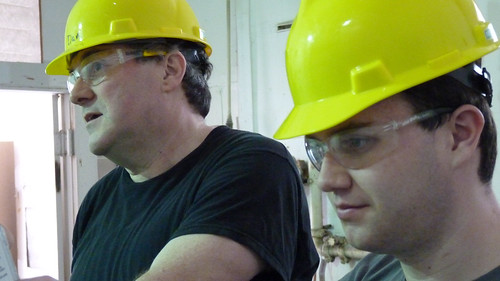




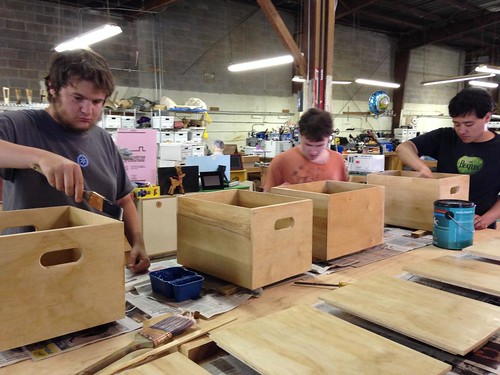






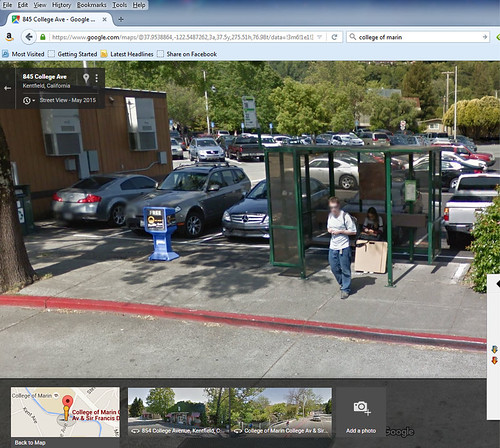
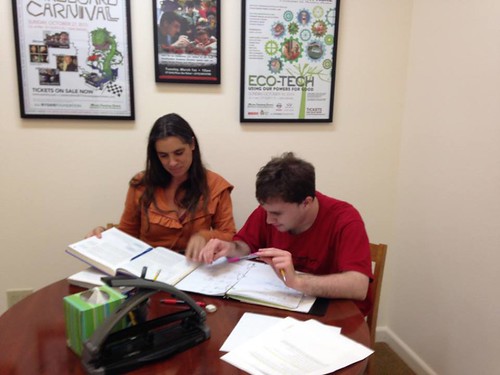



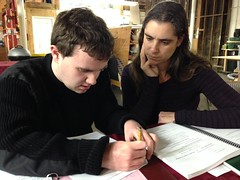





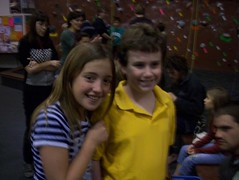

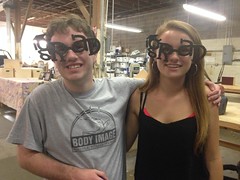
 Ian is bravely trying out a college class at College of Marin. While it is not a community college in San Francisco complete with dorms, (one of Ian’s current dreams), it is a huge step towards the independent adult life that he is trying to build for himself and that his parents are working to support with all of their hearts. In true Dan and Janet fashion, when they looked at the current programs to support students with disabilities at the local community college and found them lacking, they set out to build something better.
Ian is bravely trying out a college class at College of Marin. While it is not a community college in San Francisco complete with dorms, (one of Ian’s current dreams), it is a huge step towards the independent adult life that he is trying to build for himself and that his parents are working to support with all of their hearts. In true Dan and Janet fashion, when they looked at the current programs to support students with disabilities at the local community college and found them lacking, they set out to build something better.  Thus I am attending the class with Ian, not only to support him as a student, but to investigate the nature of supporting ASD (Autism Spectrum Disorder) individuals at the college level. In addition to thinking about balancing Ian’s needs with those of his teacher and classmates, I am going to be doing my best to think about how this support could be scaled up to meet the needs of other ASD students.
Thus I am attending the class with Ian, not only to support him as a student, but to investigate the nature of supporting ASD (Autism Spectrum Disorder) individuals at the college level. In addition to thinking about balancing Ian’s needs with those of his teacher and classmates, I am going to be doing my best to think about how this support could be scaled up to meet the needs of other ASD students. One of the joys and challenges of working with ASD individuals is the incredible diversity of their skills, talents and needs. During our first day of class, I noticed that Ian’s tendency is to tune out the intense verbal language of the lecture component of the class. While doing this, he is still working hard to stay regulated and to present an outward impression of paying attention. He is quiet and still at his desk and looks toward the teacher as she talks. Asking him questions, prompting him to write down essential concepts and reminding him to pay attention were strategies I tried to increase his level of attendance to the material being presented. I am helped in these efforts by the nature of the class, a drama class which teaches fundamental acting skills. As such, the class is taught by a woman who has a background in acting and who conducts her class in an engaging manor. High levels of affect naturally interest Ian, and prompt him to attend to the material. Another helpful element of the class is that the students tend to only spend small chunks of time on lecture material before being called to their feet and asked to put principles into active practice.
One of the joys and challenges of working with ASD individuals is the incredible diversity of their skills, talents and needs. During our first day of class, I noticed that Ian’s tendency is to tune out the intense verbal language of the lecture component of the class. While doing this, he is still working hard to stay regulated and to present an outward impression of paying attention. He is quiet and still at his desk and looks toward the teacher as she talks. Asking him questions, prompting him to write down essential concepts and reminding him to pay attention were strategies I tried to increase his level of attendance to the material being presented. I am helped in these efforts by the nature of the class, a drama class which teaches fundamental acting skills. As such, the class is taught by a woman who has a background in acting and who conducts her class in an engaging manor. High levels of affect naturally interest Ian, and prompt him to attend to the material. Another helpful element of the class is that the students tend to only spend small chunks of time on lecture material before being called to their feet and asked to put principles into active practice. During the circle exercises of the first day, passing names and gestures around a circle, first methodically and then in a random pattern, Ian displayed a very high level of engagement. He not only “got” the games, he was good at them. Over the course of these exercises, I saw the students’ perception of Ian change. Their attitude shifted from one of curiosity to one of interest, and he was chosen often by his peers to participate. He was good at remembering the names of his peers and who had or had not been already chosen. It was gratifying to see Ian engaging and succeeding. Our only interaction during this period was when he would catch my eye from across the room and I would give him a smile or thumbs-up. This first day showed me three different levels of engagement and motivation that Ian currently possesses. There was a language-based lecture that he needed a high level of support to gain benefit from, a short film sequence and some short monologue performances that Ian watched intently and was able to comment on with very little scaffolding/prompting, and there were the active exercises, which he was able to attend to and participate in without support.
During the circle exercises of the first day, passing names and gestures around a circle, first methodically and then in a random pattern, Ian displayed a very high level of engagement. He not only “got” the games, he was good at them. Over the course of these exercises, I saw the students’ perception of Ian change. Their attitude shifted from one of curiosity to one of interest, and he was chosen often by his peers to participate. He was good at remembering the names of his peers and who had or had not been already chosen. It was gratifying to see Ian engaging and succeeding. Our only interaction during this period was when he would catch my eye from across the room and I would give him a smile or thumbs-up. This first day showed me three different levels of engagement and motivation that Ian currently possesses. There was a language-based lecture that he needed a high level of support to gain benefit from, a short film sequence and some short monologue performances that Ian watched intently and was able to comment on with very little scaffolding/prompting, and there were the active exercises, which he was able to attend to and participate in without support. Our son is autistic and his autism has driven much that we have done and learned. Ian was born early in 1995 while we were living in Bloomington, Indiana. Dan was a Ph.D. candidate at Indiana University studying Astrophysics. Janet was a librarian at the local public library and was working on her Masters degree in Library and Information Science at IU. Towards the end of the pregnancy Janet’s blood pressure started to increase and she was diagnosed with preeclampsia. As her due date approached her doctors worked to induce a normal delivery. After nearly two weeks Janet’s condition deteriorated to eclampsia and Ian was delivered by emergency c-section. Ian was full term and a very healthy baby at birth.
Our son is autistic and his autism has driven much that we have done and learned. Ian was born early in 1995 while we were living in Bloomington, Indiana. Dan was a Ph.D. candidate at Indiana University studying Astrophysics. Janet was a librarian at the local public library and was working on her Masters degree in Library and Information Science at IU. Towards the end of the pregnancy Janet’s blood pressure started to increase and she was diagnosed with preeclampsia. As her due date approached her doctors worked to induce a normal delivery. After nearly two weeks Janet’s condition deteriorated to eclampsia and Ian was delivered by emergency c-section. Ian was full term and a very healthy baby at birth. But as the months passed he began to miss the usual milestones of speech development. We had one of those “What to Expect…” books and noted with increasing worry and dread each “normal” milestone he missed. He did not babble in a speech-like way in the early months. He was not drawn to noise-making toys nor did he imitate different speech sounds. He seemed totally mystified by games of Peek-a-Boo. But he always smiled. He made eye contact. And he loved to be held. Ian seemed to communicate without words. And though we thought his utter fascination with cupboard door hinges, the pliability of a sheet of paper, or the concentric ripples in a dog’s water dish was a bit eccentric we simply chalked it up to being the son of a scientist. We took comfort in the stories that Einstein didn’t speak until he was 3 years old. Even though Ian never measured up to the What to Expect timelines he nevertheless developed into an attractive, engaging and affectionate child.
But as the months passed he began to miss the usual milestones of speech development. We had one of those “What to Expect…” books and noted with increasing worry and dread each “normal” milestone he missed. He did not babble in a speech-like way in the early months. He was not drawn to noise-making toys nor did he imitate different speech sounds. He seemed totally mystified by games of Peek-a-Boo. But he always smiled. He made eye contact. And he loved to be held. Ian seemed to communicate without words. And though we thought his utter fascination with cupboard door hinges, the pliability of a sheet of paper, or the concentric ripples in a dog’s water dish was a bit eccentric we simply chalked it up to being the son of a scientist. We took comfort in the stories that Einstein didn’t speak until he was 3 years old. Even though Ian never measured up to the What to Expect timelines he nevertheless developed into an attractive, engaging and affectionate child. For financial reasons Dan quit school before finishing his Ph.D. but found that his programming skills were in very high demand back where we grew up in the San Francisco Bay Area. We moved the family to Marin County in 1997. Ian was two and a half. We did not know any pediatricians in the area so Janet somewhat randomly chose the first one found in the health insurance providers list. This doctor happened to specialize in developmental pediatrics and their first appointment, a simple well-baby checkup, stretched into nearly three hours and ended with the doctor solemnly stating: “I think we need to consider the possibility that your son is autistic.”
For financial reasons Dan quit school before finishing his Ph.D. but found that his programming skills were in very high demand back where we grew up in the San Francisco Bay Area. We moved the family to Marin County in 1997. Ian was two and a half. We did not know any pediatricians in the area so Janet somewhat randomly chose the first one found in the health insurance providers list. This doctor happened to specialize in developmental pediatrics and their first appointment, a simple well-baby checkup, stretched into nearly three hours and ended with the doctor solemnly stating: “I think we need to consider the possibility that your son is autistic.”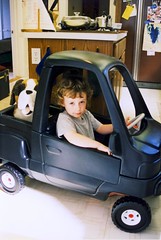

 She considered Ian to be a “low-functioning autistic”. The worst diagnosis they give. Dan remembers that the only literature he could find was that people with that diagnosis had an 80% probability of being institutionalized as adults. At that time there was very little literature to look at and none was particularly encouraging. UCSF had a list of many things they wanted Ian to do with them but we quickly saw that all they were interested in was studying Ian, not treating him. The lack of guidance as to what we should do was very upsetting to us.
She considered Ian to be a “low-functioning autistic”. The worst diagnosis they give. Dan remembers that the only literature he could find was that people with that diagnosis had an 80% probability of being institutionalized as adults. At that time there was very little literature to look at and none was particularly encouraging. UCSF had a list of many things they wanted Ian to do with them but we quickly saw that all they were interested in was studying Ian, not treating him. The lack of guidance as to what we should do was very upsetting to us. Ian, like most young children, loved Winnie the Pooh. When he first began to talk he would stay up all night reciting long passages from the Disney movies. His lilting sing-song voice was not a good lullaby so Janet was up all night with him. So she too memorized the Winnie-the-Pooh dialogue. One night as Ian recited the well worn lines Janet took the part of Tigger – “The wonderful thing about tiggers, is tiggers are wonderful things…” Ian whipped his head around, looked her right in the eye…and then burst into laughter. She had entered his world. That was the first night he fell asleep before 3am. Janet had found a way to connect with him in that very special world of his imagination.
Ian, like most young children, loved Winnie the Pooh. When he first began to talk he would stay up all night reciting long passages from the Disney movies. His lilting sing-song voice was not a good lullaby so Janet was up all night with him. So she too memorized the Winnie-the-Pooh dialogue. One night as Ian recited the well worn lines Janet took the part of Tigger – “The wonderful thing about tiggers, is tiggers are wonderful things…” Ian whipped his head around, looked her right in the eye…and then burst into laughter. She had entered his world. That was the first night he fell asleep before 3am. Janet had found a way to connect with him in that very special world of his imagination. As the parents of a newly diagnosed autistic child we entered a world where it felt like every week brought a new Thing We Could Do to Cure Our Child. Music! Horses! Computer games! No computer games! Magnets! We looked into all of them. Everyone we knew sent us literature they had found. “Have you tried….?” There was constant guilt that we were not doing enough. Constant frustration when the weekly “cure” turned out to work on ONE child in the entire world. And then friends would keep sending us information about that same cure for the next month. We came to call this: living with the threat of a cure (that you did not take advantage of!).
As the parents of a newly diagnosed autistic child we entered a world where it felt like every week brought a new Thing We Could Do to Cure Our Child. Music! Horses! Computer games! No computer games! Magnets! We looked into all of them. Everyone we knew sent us literature they had found. “Have you tried….?” There was constant guilt that we were not doing enough. Constant frustration when the weekly “cure” turned out to work on ONE child in the entire world. And then friends would keep sending us information about that same cure for the next month. We came to call this: living with the threat of a cure (that you did not take advantage of!). In Ian’s schooling we generally received good service by collaborating with the districts as best we could. We tried wherever possible to provide extra help and materials to support the classroom teachers. And we mostly managed without huge legal battles – that is not to say that there were never heated negotiations. But the outcome was always agreed to be in Ian’s best interest. Ian is currently a senior in high school and will graduate with a certificate of completion with the same group of kids he has been with since fourth grade.
In Ian’s schooling we generally received good service by collaborating with the districts as best we could. We tried wherever possible to provide extra help and materials to support the classroom teachers. And we mostly managed without huge legal battles – that is not to say that there were never heated negotiations. But the outcome was always agreed to be in Ian’s best interest. Ian is currently a senior in high school and will graduate with a certificate of completion with the same group of kids he has been with since fourth grade.
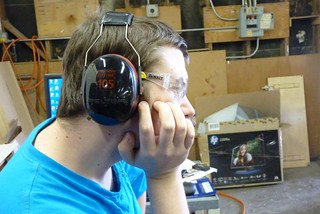 So I have not written in this blog for some time and I apologize. My intent was to do this more regularly but perhaps monthly is a better goal.
So I have not written in this blog for some time and I apologize. My intent was to do this more regularly but perhaps monthly is a better goal. 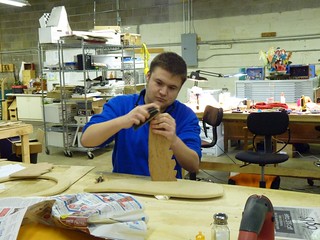 Connor has been attending a county program since finishing up high school. This is a program that stresses very little academics and has a lot of down time. We decided to have Connor attend as he needed a place where he would be engaged and around others his age. There was also a very structured transportation element that would facilitate independence in taking the bus. We had only hoped to have Connor attend for a year as we worked to figure out other post high school options. He is now in his second year and really thriving. What has happened is Connor has taken complete ownership for this program. He knows on what days he needs to bring lunch and makes his own without any involvement from us. On the days he goes to Safeway he checks with his dad about what he should purchase. Connor will also buy things that he needs like mouthwash or toothpaste. He monitors this on his own. He gets ready in the morning on his own and is always ready when the taxi arrives. We in fact do not need to be home. He is also taking the bus on his own. He is given money at the beginning of the week and has to budget for the week to cover lunches, bus fare and trips to Safeway. I share this as sometimes as parents we walk away from some programs without considering the long term impact. I have actually never visited this class when in session as I knew I would be looking for something else. Connor is almost 21 and he needs to make his own choices and also be responsible for his activities. We have really stepped back and we are the ones who are also transitioning.
Connor has been attending a county program since finishing up high school. This is a program that stresses very little academics and has a lot of down time. We decided to have Connor attend as he needed a place where he would be engaged and around others his age. There was also a very structured transportation element that would facilitate independence in taking the bus. We had only hoped to have Connor attend for a year as we worked to figure out other post high school options. He is now in his second year and really thriving. What has happened is Connor has taken complete ownership for this program. He knows on what days he needs to bring lunch and makes his own without any involvement from us. On the days he goes to Safeway he checks with his dad about what he should purchase. Connor will also buy things that he needs like mouthwash or toothpaste. He monitors this on his own. He gets ready in the morning on his own and is always ready when the taxi arrives. We in fact do not need to be home. He is also taking the bus on his own. He is given money at the beginning of the week and has to budget for the week to cover lunches, bus fare and trips to Safeway. I share this as sometimes as parents we walk away from some programs without considering the long term impact. I have actually never visited this class when in session as I knew I would be looking for something else. Connor is almost 21 and he needs to make his own choices and also be responsible for his activities. We have really stepped back and we are the ones who are also transitioning. Connor has 3 different part time jobs/internships including the Autistry Model Employment Program. He works hard at these jobs and we are hopeful that this will be a foundation for future employment as he has acquired great skills and understands better the work environment. We await word from the Department of Rehabilitation as we hope to transfer Connor to paying jobs. I will blog about that journey. We still have not accessed GGRC but will be soon.
Connor has 3 different part time jobs/internships including the Autistry Model Employment Program. He works hard at these jobs and we are hopeful that this will be a foundation for future employment as he has acquired great skills and understands better the work environment. We await word from the Department of Rehabilitation as we hope to transfer Connor to paying jobs. I will blog about that journey. We still have not accessed GGRC but will be soon.

